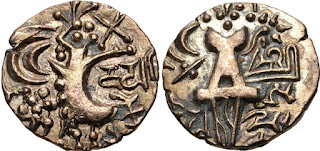The Kashmir Valley was under Ashoka during the Mauryan Empire. It remained under the Kushans, under Kanishka and Huvishika. There are many glorious empires Kashmir has witnessed and recorded, but many of them have been forgotten over the ages. One such forgotten empire is the Karkota empire. The first people with local origin who ascended the throne of the land and authentic history of Kashmir began, were the Karkotas. The Karkota Dynasty (625-855 AD) ruled over Kashmir during the 7th and 8th centuries. The Karkotas were Vaishnavas and constructed several Vishnu shrines in their dominions.
Karkotas, Vighara, gold-based coin
Karkotas are unique as they claim decent from ''karkota'', one of the great Naga or Serpent kings in the Hindu religious tradition. ''Nilamata Purana'' is an ancient text composed in the 7th century AD, in the early days of the karkota dynasty. It is a mythical account of the origins of Kashmir. According to this text, Kashmir was once a great lake known as ''Satisar''. Lord Vishnu granted the Kashmir Valley to the Nagas (serpents).
A plateau, 22 km north-west of Srinagar, overlooking the Jhelum River, locals call ''Kani Shahr'' or ''City of Stones'' was once ''Parihaspora'' or the ''City of Smiles'', the capital of Karkota Empire.
Karkota Empire, 8th century BC
Durlabhvardhana was the founder of the Kakota dynasty (625-855 AD). He was the son- in- law of King Baladitya of the Gonanda dynasty, and ascended the throne in 527 AD. According to Hiuen-Tsang who visited Kashmir and stayed in the Karkota kingdom for more than a year, the king ruled over parts of western and northwestern Punjab as well. Durlabhvardhana claimed descent from the great serpent King Karkotaka, giving the dynasty he founded, its name.
This period has references to some festivals, music and dance. The remains of the Harwan monastery depicts musicians playing instruments on the tiles, dated back to the 4th century AD. Activities of sports, wrestling and hunting are also depicted.
Durlabhavardhan was succeeded by his son Pratapaditya (662-712 AD). He founded the new town of Pratapapura, present day Tapar, 29 km west of Srinagar. Pratapaditya was succeeded by his son Chandrapida (713-720 AD). During this time Chandrapida sought help from China to repulse the Tibetans who had entrenched themselves forcefully. Chandrapida's younger brother Lalitaditya Muktapida also called the ''Napoleon of Kashmir'' acceded the throne in 724 AD.
Lalitaditya ruled for 37 years from 724-761 AD. His rule is considered the Golden Age of Kashmir, when art, culture, learning and architecture flourished. The 12th century chronicler Kalhana characterizes Lalitaditya with extensive conquests into the eastern and southern parts of India as well as present day Afghanistan. He is accepted as the most powerful king of his dynasty. He established his capital at Parihaspora, although he also maintained the dynasty's traditional capital at Srinagar.
He founded Suniscatapur and Darpitapur, two towns, as also Lalitpura, presently called Letapur, near Pulwama. It is claimed that a Vishnu statue weighing 36,000 kg of silver and a Buddha statue weighing 62,000 kg of copper were erected in Parihaspora. Martand Sun Temple in Anantnag district was built by him. The scale of temple ruins even today suggests that the temple central shrine was surrounded by 84 small shrines and were a blend of architectural styles of the Gandhara, Gupta, Chinese, Roman and the Greek.
Ruins of the Martand Sun Temple
Lalitaditya died around 760 AD and was succeeded by a series of weak and ineffective kings, Kuvalayapida, Vajraditya and Prithivyapida.
Later Jayapida, who ruled for 31 years, conquered upto Allahabad, built many towns namely Jayapura near Wular lake and Malhanpur, present day Malur, on the bank of Jhelum, and Kalyanpura, present day Kalampur and Kamlapura. He was also known as Vinayaditya
His son ruled for 12 years and lost a lot of wealth. The last ruler was a boy Cippatajayapida. He was murdered around 840 AD and with him came an end of the dynasty. In 855 AD, the Utpala kings were the last Hindu dynasty of Kashmir, before the advent of Islam
Karkota coins kidarite
Note: Goddess Ardoksho depicts Lakshmi, on the coins
Pratapaditya II, 5th century AD, Base dinar, weight 7.0 gm
Obverse: Kushan style king standing left
Reverse: Goddess Ardoxsho seated facing
Kidarite, Namvihakya, 5th century AD, base gold, Dinar, weight 7.9 gm, standing figure, srinamvi to right, hakya to left
Vigraha Deva, 5th century AD, weight 7.7 gm, figure of king standing left ''kidara'' under right arm ''ka'' in left field, reverse, figure of goddess facing ''Sri Vigraha'' right, ''Deva'' left
Mamvihakya, 5th century AD, Dinar, weight 7.9 gm
Obverse: King standing left, ''ka'' in Brahmi to left, monogram of Kidara and Jaya in Brahmi to right
Reverse: Ardoxsho seated facing holding filleted investiture garland and cornucopia, ''hakya'' in Brahmi to left, ''sri namvi'' in Brahmi down right
Pratapaditya II, 5th century AD, debased gold dinar, weight 7.0 gm
Obverse: king standing facing at altar at left, Brahmi legend under arm ''Kidara'' additional letter ''ka'' at left
Reverse: Goddess Ardoksho enthroned, Brahmi legend at right ''Sri Pratapa''


















Super trove from your collection.There is so much ignorance of our history ,especially this era,which was a golden age.No mention of great Lalitaditya anywhere in our school text books of
ReplyDeleteA very fascinating insight into the history of Kashmir which very few are aware of. The ancient ruins and coins dating back to the Karkotas, King Harshavardhan represent a glorious era
ReplyDelete